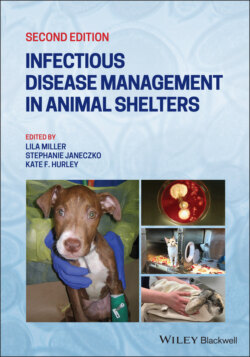Читать книгу Infectious Disease Management in Animal Shelters - Группа авторов - Страница 127
4.7 Conclusion
ОглавлениеA thoughtfully employed diagnostic testing strategy can ensure cost‐effective protection of animal health and welfare in the shelter environment. Practitioners need not dismiss diagnostic testing as unattainable or unrealistic simply due to resource limitations. In fact, many of the most clinically useful diagnostic tools require minimal financial investment and thoughtful use of timely, targeted testing can often be a more cost‐efficient strategy when all operational costs are considered. Careful use of the core diagnostic modalities—case history, physical examination, and response to treatment—will establish a sound treatment plan in many, if not the majority of shelter patients. With a modest budget, basic diagnostic supplies and equipment can be obtained allowing for a great spectrum of diagnostic capabilities through both primary and secondary diagnostic tests at a minimal cost. Such information can adequately guide the short‐ and long‐term care of a variety of medical conditions in the shelter environment. Resources should also be reserved for advanced diagnostic laboratory testing and disease outbreak response when indicated.
Shelter practitioners should have a keen understanding of the benefits and drawbacks of each testing modality in order to select the most appropriate test for a given clinical situation and accurately interpret the results. Diagnostic testing protocols should be developed for both individual‐ and population‐level health maintenance; they should be written and accessible. Such protocols should be designed by a veterinarian with knowledge of the animal population as well as familiarity with shelter medicine principles and take into account the risks and benefits of testing as well as those of obtaining erroneous results. Consideration of each of these factors in the development of sound diagnostic protocols can lead to efficient and effective disease treatment and, better yet, disease prevention—the ultimate rewards for all of us working to improve animal health and welfare.
Figure 4.3 Infectious disease diagnostic algorithm for clinical signs of common infectious GI diseases including vomiting, diarrhea, anorexia, and weight loss. CPV, canine parvovirus; FPV, feline parvovirus.
Figure 4.4 Infectious disease diagnostic algorithm for clinical signs of common infectious respiratory diseases including sneezing, coughing conjunctivitis, and oculo‐nasal discharge. CDV, canine distemper virus; TTW, trans‐tracheal wash; BAL, bronchoalveolar lavage.
Figure 4.5 Infectious disease diagnostic algorithm for clinical signs of common infectious dermatologic diseases including alopecia, pruritus, papules, pustules, scaling, crusting, erythema, and nodules. DTM, dermatophyte test medium.
